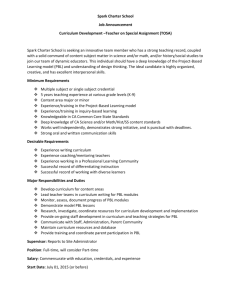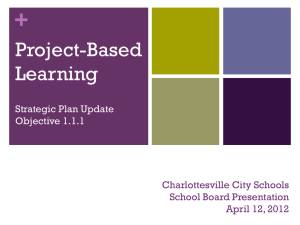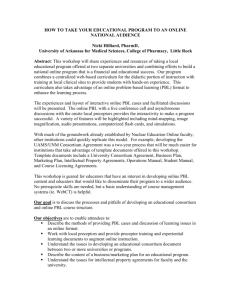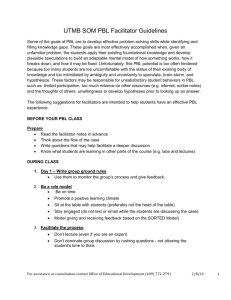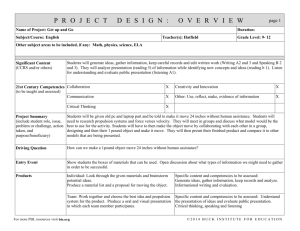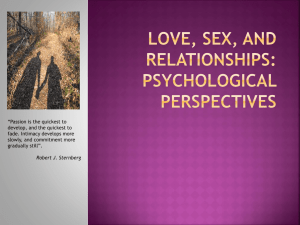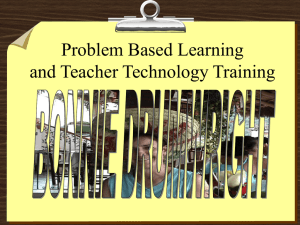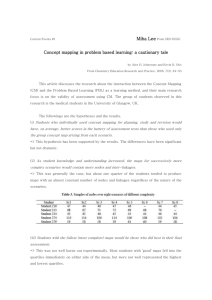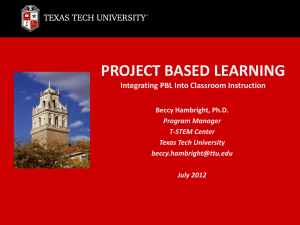Understanding Project-Based Learning PowerPoint Presentation
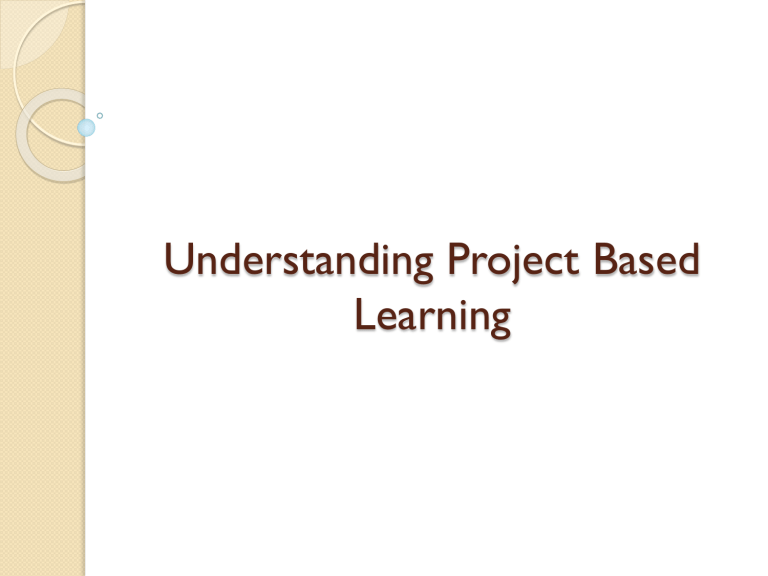
Understanding Project Based
Learning
1
Five Characteristics of PBL
1.
2.
3.
4.
5.
Projects must be central, not peripheral to the curriculum
Projects are focused on questions or problems that lead students to learn the central concepts and principles of a discipline.
Projects involve students in a constructive investigation.
Projects are student-driven to some significant degree.
Projects are realistic, not school-like.
2
1) Projects must be central, not peripheral to the curriculum
(“projects are the curriculum”)
3
2) Projects are focused on questions or problems that lead students to learn the central concepts and principles of a discipline.
4
3) Projects involve students in a constructive investigation.
5
4) Projects are student-driven to some significant degree
6
5) Projects are realistic, not school-like.
7
21
st
Century Skills Assessment
http://www.bie.org/videos/video/21st_cen tury_skills_assess
8
Assessing PBL Projects
Assessment meets many needs. It provides diagnostic feedback.
helps educators set standards.
allows one to evaluate progress and relate that progress to others.
gives students feedback on how well they understand the information and on what they need to improve.
helps the teacher design instruction to teach more effectively.
Whenever possible, give the students the opportunity to conduct self-assessment. When a student's assessment and the teacher's assessment don't agree, schedule a studentteacher conference to let the student explain in more detail his or her understanding of the content and justify the outcome.
9
10
Steps to enabling effective self-evaluation
2.
3.
4.
5.
1.
Take time to reflect, individually and as a group.
Share feelings and experiences.
Discuss what worked well.
Discuss what needs change.
Share ideas that will lead to new questions and new projects.
11
Vignettes to analyze
1. Read one of the vignettes (Alabama or South
Carolina) placed on your table.
2. Be prepared to share one piece of evidence to explain what is different.
12
Project Launch
Now, with your table team, improve your list by comparing notes on what the project is asking you to do.
13
Jigsaw reading in PBL
Jigsaw is a cooperative learning strategy that enables each student of a "home" group to specialize in one aspect of a topic (for example, one group studies habitats of rainforest animals, another group studies predators of rainforest animals). Students meet with members from other groups who are assigned the same aspect, and after mastering the material, return to the
"home" group and teach the material to their group members. With this strategy, each student in the "home" group serves as a piece of the topic's puzzle and when they work together as a whole, they create the complete jigsaw puzzle.
14
Three Benefits of using Jigsaw learning
1.
2.
3.
It helps build comprehension.
It encourages cooperative learning among students.
It helps improve listening, communication, and problem-solving skills
15
Resources:
www.bie.org
Thomas, J. W. (2000). A review of research on project-based learning. Report prepared for
The Autodesk Foundation. Retrieved May 18, 2009 from http://www.bie.org/index.php/site/RE/pbl_research/29 http://genyes.org/media/freeresources/assessing_tech_literacy_whitepaper.pdf
Photos from Boston Day Evening Academy -http://www.bacademy.org/insidebdea/curriculum
Individual and group work PBL for STTI and the classroom http://www.edutopia.org/project-based-learning-guide-implementation#pbl_assess http://www.readingrockets.org/strategies/jigsaw/ https://sites.google.com/a/leyden212.org/mapping/components/assessments/formative-vssummative http://www.southbendcareeracademy.org/index.php?option=com_content&view=article&i d=37:projects-vs-pbl&catid=19:class-room-articles&Itemid=101 https://sites.google.com/a/leyden212.org/mapping/components/assessments/formative-vssummative
16

